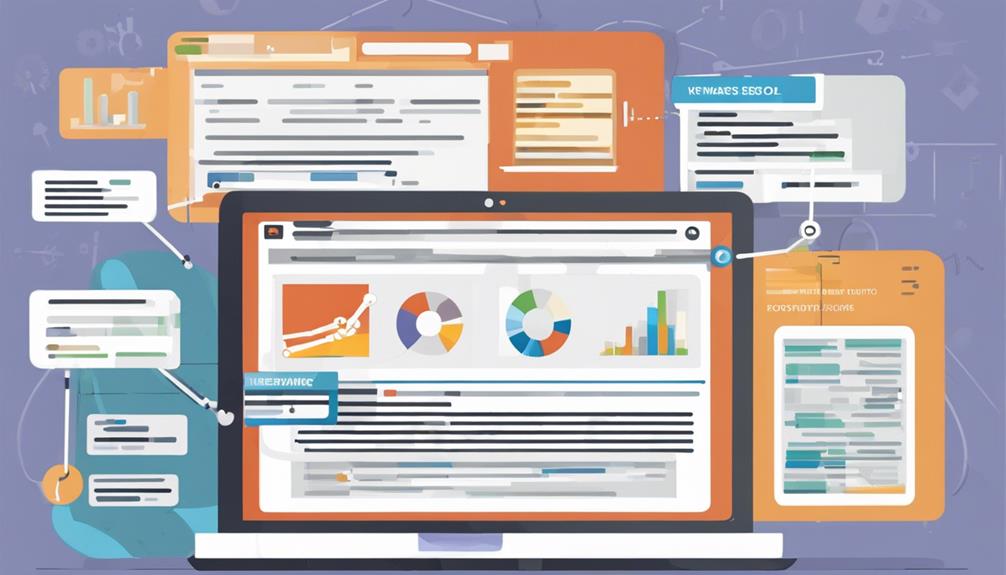
If you want to boost your website's visibility and climb the search engine rankings, mastering on-page SEO analysis is key. By optimizing your title tags, meta descriptions, and enhancing user experience, you lay a strong foundation for success.
But what about the finer details that can set your site apart from the competition? Stay tuned to uncover the top 10 on-page SEO tips for 2021 that can take your digital presence to the next level.
Key Takeaways
- Align web pages with search intent and use relevant keywords strategically for improved visibility.
- Craft compelling title tags and meta descriptions under character limits with balanced keywords.
- Optimize images with descriptive alt text, filenames, and size for enhanced site performance.
- Improve user experience, credibility, and SEO with fast page speed, user-friendly design, and E-A-T focus.
Content Optimization
To optimize your content effectively for improved search engine visibility and relevance, aligning your web pages with search intent is paramount. Content optimization involves ensuring that your content aligns with what users are searching for.
Incorporating relevant keywords, utilizing canonical tags to prevent content duplication, and implementing schema markup to enhance the visibility of your content are essential strategies. Canonical tags help search engines understand which version of similar content to prioritize, ultimately improving your site's SEO performance.
Additionally, schema markup provides search engines with more context about your content, increasing the likelihood of appearing in rich snippets and improving click-through rates.
Title Tag Best Practices
Keep your title tags concise, aiming for under 60 characters to ensure visibility in search results.
Strategically place relevant keywords to enhance your search engine rankings and attract more traffic.
Remember to maintain a balance by avoiding keyword stuffing to uphold readability and user engagement.
Title Length Guidelines
Ensuring optimal title length within the prescribed character limit is paramount for maximizing search visibility and user engagement in on-page SEO strategies for 2021. When crafting your title tags, keep the following guidelines in mind:
- Stay under 60 characters: To prevent truncation in search results and ensure full visibility.
- Focus on the first 50-60 characters: Google typically displays this portion, so make it count.
- Avoid keyword stuffing: Maintain a balance for a better user experience and avoid penalties.
- Craft unique and compelling titles: Incorporate relevant keywords for improved click-through rates and organic traffic.
Following these practices will help boost your SEO performance and attract more organic traffic to your site.
Keyword Placement Strategies
Crafting an effective keyword placement strategy is essential for optimizing your title tags and enhancing your website's search visibility in 2021. Placing keywords at the beginning of your title tags can significantly impact search rankings. It's recommended to keep title tags under 60 characters to ensure they display correctly in search results.
Avoiding keyword stuffing in your title tags is crucial to maintain readability and prevent penalties from search engines. By incorporating relevant keywords in your title tags, you help search engines better understand your content, improving visibility. Well-crafted title tags not only increase click-through rates but also attract more organic traffic to your website.
Meta Description Optimization
Crafting an optimal meta description is crucial for your on-page SEO strategy. Keeping the length under 155-160 characters ensures full visibility in search results.
Including relevant keywords and a compelling call-to-action can significantly boost click-through rates.
Length and Relevance
To optimize your meta description effectively in 2021, aim for a concise length of 150-160 characters to ensure optimal visibility and click-through rates in search results.
Including relevant keywords in your meta descriptions can significantly impact your click-through rates and search engine visibility. These short snippets serve as a preview of your content, influencing users' decisions to click on your link.
Crafting compelling meta descriptions not only attracts more clicks from search engine users but also boosts organic traffic. Well-crafted meta descriptions can lead to higher engagement and better overall performance in search results.
- Aim for 150-160 characters for optimal visibility.
- Include relevant keywords to improve click-through rates.
- Use meta descriptions as previews to influence user decisions.
- Crafting compelling snippets can increase organic traffic.
Call-To-Action Inclusion
Optimizing your meta descriptions with a compelling call-to-action can significantly boost click-through rates and user engagement on search engine results pages. Including a strong call-to-action in meta descriptions has shown to increase click-through rates by up to 20%.
Meta descriptions that feature a clear call-to-action often result in higher conversion rates and increased engagement from search engine users. By incorporating specific calls-to-action in your meta descriptions, you can enhance the effectiveness of your on-page SEO strategy.
A well-crafted call-to-action prompts users to take desired actions, such as clicking through to your website. This strategic approach not only guides users towards the intended next steps but also contributes to an improved overall user experience.
Image SEO Techniques
Implementing effective image SEO techniques is crucial for enhancing website performance and increasing visibility in search engine results. Proper image optimization can significantly impact user experience and SEO efforts.
Here are four essential tips for optimizing images on your website:
- Alt Text: Including descriptive alt text for images is vital for improving accessibility and helping search engines understand the content. This not only enhances SEO but also ensures all users, including those using screen readers, can comprehend the image.
- Image Optimization: Compressing images to reduce file size is crucial for faster page load speed. This optimization enhances user experience, decreases bounce rates, and signals search engines that your site is well-maintained.
- Filename Relevance: Using relevant filenames for images provides context to search engines, contributing to better SEO. Ensure your filenames are descriptive and include relevant keywords to improve visibility in search results.
- Image Size Optimization: Optimizing image size for the web is essential for boosting page load speed and improving overall site performance. By reducing the size of images without compromising quality, you can enhance user experience and SEO simultaneously.
URL Structure Optimization
Enhancing your website's URL structure is a pivotal element in on-page SEO optimization, directly impacting search engine rankings and user experience.
To optimize your URL structure effectively, aim for user-friendly URLs that are concise and descriptive. Including target keywords in your URLs not only helps search engines better understand your content but also improves your chances of ranking higher in search results.
When crafting your URLs, it's recommended to use hyphens to separate words for better readability and SEO optimization. User-friendly URLs that accurately reflect the content of your pages can significantly enhance user experience and make navigation more intuitive.
Internal Linking Strategies
Strategically linking relevant pages within your website is crucial for improving user experience and SEO.
Optimizing anchor text can enhance the context of your internal links, benefiting both users and search engines.
Efficiently distributing link equity through internal linking helps boost the authority of key pages on your site.
Link Relevance Importance
Internal linking plays a crucial role in optimizing your website's SEO by establishing connections between different pages and enhancing their overall relevance. When it comes to link relevance importance, here are some key points to consider:
- SEO Value: Relevant internal links can pass link equity and authority, improving the SEO value of interconnected pages.
- User Experience: Strategic internal linking enhances user experience by guiding visitors to related content and keeping them engaged.
- Anchor Text: Ensure that anchor text in internal links is descriptive and relevant to maximize SEO benefits.
- Crawling Efficiency: Internal linking helps search engine crawlers discover and index new pages efficiently, improving search result visibility.
Anchor Text Optimization
To optimize your on-page SEO effectively, anchoring text with relevant keywords is essential for enhancing search engine visibility and user engagement. When it comes to internal linking strategies, anchor text optimization plays a crucial role.
By using descriptive and keyword-rich anchor text, you provide valuable context to search engines, helping them understand the relevance and relationship between linked pages. Strategic internal linking with optimized anchor text not only improves website navigation but also enhances the overall user experience.
However, it's important to maintain a balance between diversity and relevance in your anchor text to avoid penalties from search engines. By carefully crafting your anchor text, you can boost the effectiveness of your internal linking for on-page SEO.
Link Juice Distribution
Distributing link juice effectively through internal linking is a fundamental aspect of maximizing SEO performance and enhancing website authority. When strategizing internal linking, consider the following:
- Enhancing SEO Performance: Internal linking helps distribute link equity and authority throughout your website, boosting overall SEO performance.
- Improving Visibility: Strategic internal linking guides search engine crawlers to important pages, increasing their visibility and importance.
- Enhancing User Experience: Linking related content together provides a better user experience, encouraging visitors to explore more of your site.
- Establishing Information Hierarchy: Proper internal linking establishes a logical hierarchy of information, aiding both users and search engines in navigating your site effectively. Utilize anchor text strategically to improve keyword relevance and emphasize the importance of specific pages to search engines.
User Experience Enhancement
Enhancing user experience on your website is crucial for maximizing engagement and driving significant improvements in key metrics. User experience plays a critical role in determining the success of your site.
One key aspect to focus on is page speed. Research shows that 47% of users expect a webpage to load in 2 seconds or less for an optimal experience. Faster load times not only satisfy users but also impact SEO rankings positively. A 16% increase in conversion rates is observed for every second of improved load time.
Moreover, user-friendly websites tend to rank higher in search engines. Neglecting user experience can have adverse effects, as 88% of online consumers are less likely to return to a site after a poor experience.
Featured Snippet Optimization
Maximizing the visibility of your website through featured snippet optimization is a strategic approach for capturing organic traffic and increasing click-through rates. To effectively optimize for featured snippets and enhance your chances of being showcased at the top of search results, consider the following:
- Understand Featured Snippets: Featured snippets are prime real estate on search engine results pages, making them highly valuable for driving traffic to your site.
- Optimize Content: Tailor your content to match the format commonly used in featured snippets, such as providing direct answers to frequently asked questions.
- Focus on User Intent: Align your content with the specific queries and user intent that typically trigger featured snippets, increasing the likelihood of your content being selected.
- Utilize Structured Data: Implement structured data markup to help search engines better understand your content, improving your chances of being chosen for a featured snippet.
E-A-T Implementation
Implementing E-A-T guidelines is essential for enhancing website credibility and trustworthiness, crucial factors that significantly impact search engine rankings and user perception. E-A-T, which stands for Expertise, Authoritativeness, and Trustworthiness, plays a vital role in Google's search algorithm.
By focusing on E-A-T implementation, you can improve your website's credibility and trust among users and search engines alike. Websites that exhibit high levels of E-A-T are more likely to rank well in search results and attract organic traffic.
Google uses E-A-T as a measure to evaluate the quality and reliability of content, particularly in YMYL (Your Money or Your Life) niches where trust is paramount. To enhance E-A-T, you should showcase expertise in your field, establish authority through credible sources and backlinks, and build trust by maintaining a positive reputation.
Structured Data Integration
To optimize your website's performance in search engine rankings and enhance user experience, integrating structured data is a strategic imperative that provides a foundation for improved content categorization and visibility. By incorporating structured data into your web pages, you can enhance the way search engines interpret and present your content, ultimately leading to better visibility and user engagement.
Here are four key benefits of structured data integration:
- Enhanced Understanding: Structured data integration helps search engines understand and categorize your content more effectively.
- Rich Snippets: Implementing structured data can lead to rich snippets in search engine results, enhancing visibility and click-through rates.
- Improved User Experience: It enables search engines to display more informative and visually appealing results for users.
- Better Search Listings: Structured data markup can improve the accuracy and relevance of your website's search listings.
What Are Some Additional On-Page SEO Analysis Tips for 2021?
When looking for top onpage SEO tips 2021, consider focusing on user experience, optimizing for mobile, improving page speed, utilizing multimedia content, optimizing meta tags and descriptions, enhancing internal linking structure, and leveraging long-tail keywords. Conduct thorough keyword research and regularly update and improve your content for better on-page SEO performance.
Conclusion
Congratulations on mastering these top on-page SEO analysis tips for 2021! You're now equipped to conquer the digital realm with optimized content, user-friendly experiences, and enhanced search engine visibility.
Remember, staying ahead of the competition requires constant evolution and adaptation. So, keep refining your strategies, experimenting with new techniques, and never stop learning.
With these tools in your arsenal, you're ready to dominate the SEO game like a pro. Keep up the great work!
- How to Plan a Content Calendar That Works - 29/10/2025
- SEO Content vs. Social Media Content: What’s the Difference? - 23/10/2025
- The Best Types of Content for Service Businesses - 16/10/2025


